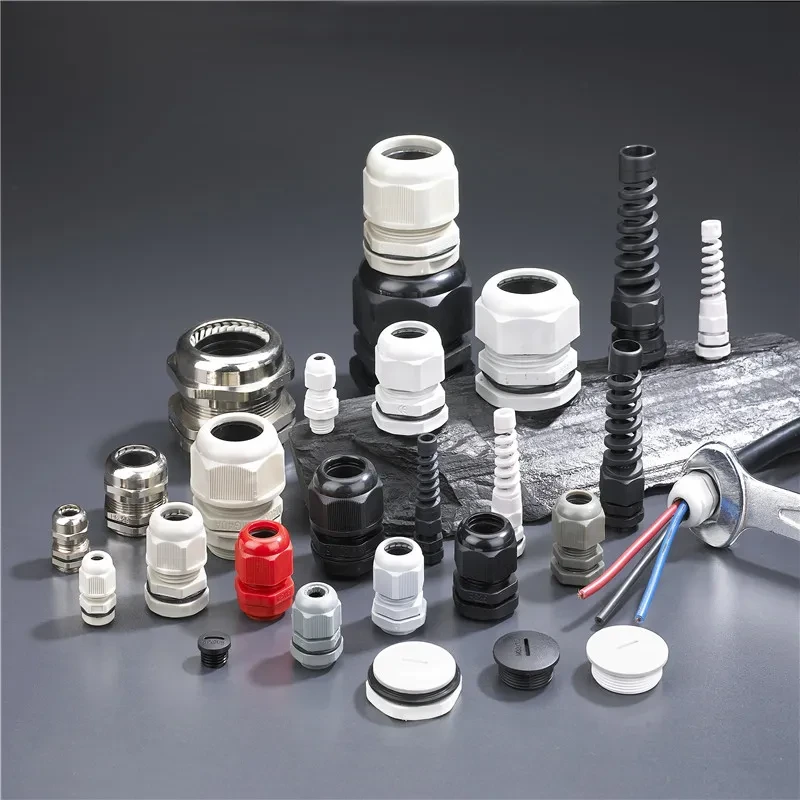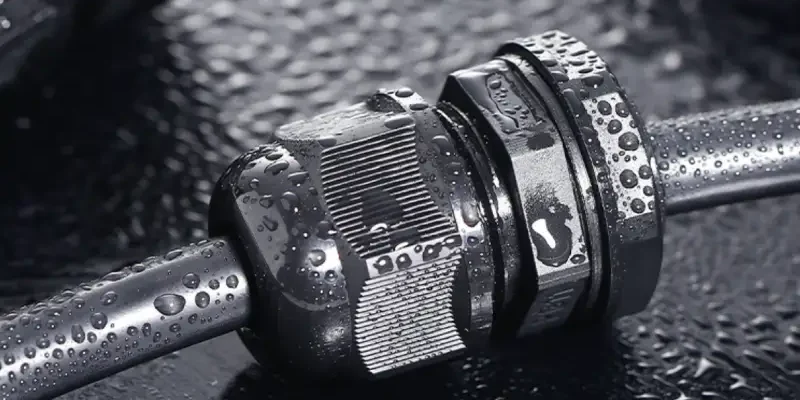Вступ
У світі електроустановок забезпечення надійних і безпечних з'єднань має першорядне значення. Одним з найважливіших компонентів, який відіграє в цьому важливу роль, є кабельний ввід. У цьому блозі ми розглянемо 4 типи кабельних вводів, висвітлимо їхні ключові особливості та детально ознайомимося з таблицею розмірів кабельних вводів SWA, щоб допомогти вам приймати обґрунтовані рішення для ваших електротехнічних проектів.
Що таке 4-х жильний кабельний ввід?
Кабельні вводи для 4-х жильного кабелю - це важливий компонент, який використовується в електротехніці для захисту та ущільнення кабелів, що вводяться в шафу. Розроблені спеціально для кабелів з чотирма жилами, вони забезпечують захист від таких факторів навколишнього середовища, як пил і волога, що робить їх придатними як для промислових, так і для комерційних інсталяцій.

Основні характеристики 4-х жильних кабельних вводів
Захист
4-жильні кабельні вводи забезпечують надійний бар'єр від забруднень, гарантуючи, що бруд, волога та інші елементи навколишнього середовища не порушать цілісність електричної системи. Це гарантує довговічність і надійність у складних умовах експлуатації.
Зняття напруги
Ці кабельні вводи ефективно справляються з механічним навантаженням на кабелі, запобігаючи пошкодженню від згинання, розтягування та інших фізичних зусиль. Таке зняття натягу має вирішальне значення для підтримання працездатності та безпеки електроустановки.
Рейтинги захисту від проникнення
Високі ступені захисту від проникнення (IP), такі як IP67 і IP68, є загальними для 4-х жильних кабельних вводів і вводів проводки. Ці показники вказують на здатність вводів протистояти впливу води та пилу, що забезпечує їхню придатність як для внутрішнього, так і для зовнішнього застосування.
Поширені розміри та технічні характеристики
4-х жильні кабельні вводи доступні в різних розмірах для кабелів різного діаметру. Ось деякі типові характеристики:
| Розмір залози | Розмір різьби | Діапазон діаметрів кабелю | Довжина залози |
|---|---|---|---|
| 16 мм | M25 | від 10 мм до 14 мм | ~60мм |
| 95 мм | M63 | 32 мм до 48 мм | ~85 мм |
| 120 мм | M90 | від 50 мм до 70 мм | ~110мм |
| 150 мм | M100 | від 60 мм до 80 мм | ~ 120 мм |
| 185 мм | M125 | від 80 мм до 100 мм | ~150мм |
Ці технічні характеристики забезпечують надійну фіксацію навколо кабелю, забезпечуючи ефективне ущільнення та підтримку, необхідну для надійного електричного з'єднання.
Матеріальні міркування
Вибір правильного матеріалу для 4-х жильного кабельного вводу має важливе значення для забезпечення його придатності до умов застосування. Поширені матеріали включають:
- Пластик: Легкі та стійкі до корозії пластикові сальники ідеально підходять для використання всередині приміщень, де вплив навколишнього середовища мінімальний.
- Латунь / нікельована латунь: Ці матеріали відрізняються довговічністю і стійкістю до корозії, що робить їх придатними для використання в суворих умовах. Нікельована латунь забезпечує додатковий рівень захисту від корозії.
- Нержавіюча сталь: Забезпечуючи чудову стійкість до корозії, сальники з нержавіючої сталі ідеально підходять для промислових застосувань, які вимагають високої міцності та захисту.
Схема кабельних вводів SWA
Важливою частиною вибору правильного кабельного вводу є розуміння відповідних розмірів для різних конфігурацій кабелів. Наведена нижче таблиця розмірів кабельних вводів SWA допомагає визначити правильний розмір для конкретних конфігурацій і розмірів кабельних жил:
| Розмір кабелю | 1 Ядро | 2 Core | 3 Core | 4 Core | 5 Core | 7 Core | 12 Core | 19 Ядро | 27 Ядро | 37 Ядро | 48 Core |
|---|---|---|---|---|---|---|---|---|---|---|---|
| 1,5 мм² | – | 20S | 20S | 20S | 20S | 20 | 25 | 25 | 32 | 32 | 32 |
| 2,5 мм² | – | 20S | 20S | 20S | 20 | 20 | 25 | 25 | 32 | 40 | 40 |
| 4,0 мм² | – | 20S | 20S | 20 | 20 | 20 | 25 | 32 | 40 | 40 | 50 |
| 6.0 мм² | – | 20 | 20 | 20 | 20 | 25 | – | – | – | – | – |
| 10,0 мм² | – | 20 | 20 | 25 | 25 | – | – | – | – | – | – |
| 16.0 мм² | – | 25 | 25 | 25 | 25 | – | – | – | – | – | – |
| 25.0 мм² | – | 25 | 25 | 32 | 32 | – | – | – | – | – | – |
| 35,0 мм² | – | 32 | 32 | 32 | 40 | – | – | – | – | – | – |
| 50.0 мм² | 20 | 32 | 32 | 40 | 50 | – | – | – | – | – | – |
| 70.0 мм² | 20 | 32 | 32 | 40 | 50 | – | – | – | – | – | – |
| 95,0 мм² | 25 | 32 | 40 | 50S | – | – | – | – | – | – | – |
| 120,0 мм² | 25 | 40 | 50S | 50 | – | – | – | – | – | – | – |
| 150.0 мм² | 32 | 40 | 50S | 50 | – | – | – | – | – | – | – |
| 185,0 мм² | 32 | 50S | 50 | 63S | – | – | – | – | – | – | – |
| 240.0 мм² | 32 | 50 | 63S | 63 | – | – | – | – | – | – | – |
| 300.0 мм² | 40 | 63S | 63 | 75S | – | – | – | – | – | – | – |
| 400.0 мм² | 40 | 63S | 75S | 75 | – | – | – | – | – | – | – |
Висновок
Розуміння специфікацій 4-х жильних кабельних вводів і використання таблиці кабельних вводів SWA має важливе значення для забезпечення ефективної та безпечної роботи електроустановок. Вибравши відповідний розмір і матеріал вводу, електрики та інженери можуть підвищити довговічність і надійність електричних систем, запобігаючи потенційним небезпекам. Пам'ятайте, що ретельний вибір і регулярне обслуговування кабельних вводів є ключем до підтримання оптимальної продуктивності будь-якої електричної установки.
Незалежно від того, чи працюєте ви над промисловою електричною установкою, чи над комерційним проектом, правильний 4-жильний кабельний ввід може суттєво вплинути на безпеку та ефективність вашої системи. Скористайтеся цим посібником, щоб зорієнтуватися у виборі та забезпечити міцні та надійні з'єднання у вашій електричній інфраструктурі.
Дізнайтеся більше з Viox Electric
Незалежно від того, чи працюєте ви над електроустановкою промислового масштабу, чи над комерційним проектом, правильний 4-х жильний кабельний ввід може суттєво вплинути на безпеку та ефективність вашої системи. Компанія Viox Electric пропонує широкий асортимент високоякісних кабельних вводів для задоволення ваших конкретних потреб. Відвідати viox.com/cable-gland для отримання додаткової інформації, ознайомлення з нашою продукцією або для запитів на придбання. Наша команда експертів готова допомогти вам у виборі ідеального кабельного вводу для вашого проекту.


